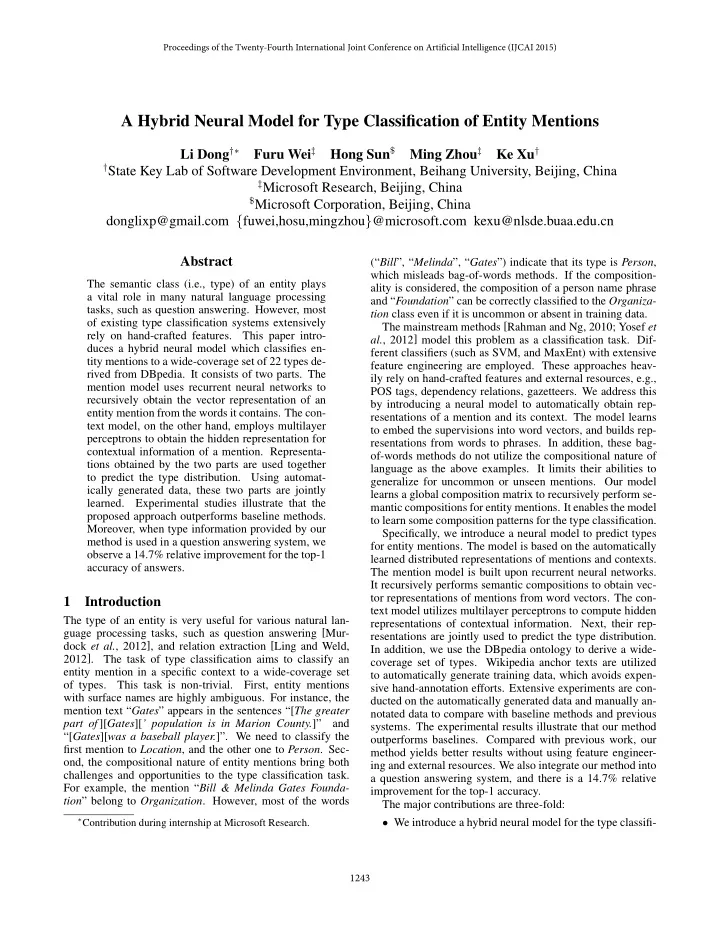

Proceedings of the Twenty-Fourth International Joint Conference on Artificial Intelligence (IJCAI 2015) A Hybrid Neural Model for Type Classification of Entity Mentions Li Dong †∗ Furu Wei ‡ Hong Sun $ Ming Zhou ‡ Ke Xu † † State Key Lab of Software Development Environment, Beihang University, Beijing, China ‡ Microsoft Research, Beijing, China $ Microsoft Corporation, Beijing, China donglixp@gmail.com { fuwei,hosu,mingzhou } @microsoft.com kexu@nlsde.buaa.edu.cn Abstract (“ Bill ”, “ Melinda ”, “ Gates ”) indicate that its type is Person , which misleads bag-of-words methods. If the composition- The semantic class (i.e., type) of an entity plays ality is considered, the composition of a person name phrase a vital role in many natural language processing and “ Foundation ” can be correctly classified to the Organiza- tasks, such as question answering. However, most tion class even if it is uncommon or absent in training data. of existing type classification systems extensively The mainstream methods [Rahman and Ng, 2010; Yosef et rely on hand-crafted features. This paper intro- al. , 2012] model this problem as a classification task. Dif- duces a hybrid neural model which classifies en- ferent classifiers (such as SVM, and MaxEnt) with extensive tity mentions to a wide-coverage set of 22 types de- feature engineering are employed. These approaches heav- rived from DBpedia. It consists of two parts. The ily rely on hand-crafted features and external resources, e.g., mention model uses recurrent neural networks to POS tags, dependency relations, gazetteers. We address this recursively obtain the vector representation of an by introducing a neural model to automatically obtain rep- entity mention from the words it contains. The con- resentations of a mention and its context. The model learns text model, on the other hand, employs multilayer to embed the supervisions into word vectors, and builds rep- perceptrons to obtain the hidden representation for resentations from words to phrases. In addition, these bag- contextual information of a mention. Representa- of-words methods do not utilize the compositional nature of tions obtained by the two parts are used together language as the above examples. It limits their abilities to to predict the type distribution. Using automat- generalize for uncommon or unseen mentions. Our model ically generated data, these two parts are jointly learns a global composition matrix to recursively perform se- learned. Experimental studies illustrate that the mantic compositions for entity mentions. It enables the model proposed approach outperforms baseline methods. to learn some composition patterns for the type classification. Moreover, when type information provided by our Specifically, we introduce a neural model to predict types method is used in a question answering system, we for entity mentions. The model is based on the automatically observe a 14.7% relative improvement for the top-1 learned distributed representations of mentions and contexts. accuracy of answers. The mention model is built upon recurrent neural networks. It recursively performs semantic compositions to obtain vec- tor representations of mentions from word vectors. The con- 1 Introduction text model utilizes multilayer perceptrons to compute hidden The type of an entity is very useful for various natural lan- representations of contextual information. Next, their rep- guage processing tasks, such as question answering [Mur- resentations are jointly used to predict the type distribution. dock et al. , 2012], and relation extraction [Ling and Weld, In addition, we use the DBpedia ontology to derive a wide- 2012]. The task of type classification aims to classify an coverage set of types. Wikipedia anchor texts are utilized entity mention in a specific context to a wide-coverage set to automatically generate training data, which avoids expen- of types. This task is non-trivial. First, entity mentions sive hand-annotation efforts. Extensive experiments are con- with surface names are highly ambiguous. For instance, the ducted on the automatically generated data and manually an- mention text “ Gates ” appears in the sentences “[ The greater notated data to compare with baseline methods and previous part of ][ Gates ][ ’ population is in Marion County. ]” and systems. The experimental results illustrate that our method “[ Gates ][ was a baseball player. ]”. We need to classify the outperforms baselines. Compared with previous work, our first mention to Location , and the other one to Person . Sec- method yields better results without using feature engineer- ond, the compositional nature of entity mentions bring both ing and external resources. We also integrate our method into challenges and opportunities to the type classification task. a question answering system, and there is a 14.7% relative For example, the mention “ Bill & Melinda Gates Founda- improvement for the top-1 accuracy. tion ” belong to Organization . However, most of the words The major contributions are three-fold: • We introduce a hybrid neural model for the type classifi- ∗ Contribution during internship at Microsoft Research. 1243
Recommend
More recommend